摘要
看完本文你将掌握如下知识点:
- 如何搭建一个SpringBoot项目
- SpringBoot自动配置原理
- SpringBoot属性配置方法
- 修改默认的Logback日志为log4j和log4j2的方法
- 修改默认的内置tomcat容器为Jetty容器和Undertow容器的方法
- SpringBoot单元测试方法
- 使用war包运行项目
SpringBoot系列:Spring Boot学习笔记
Spring Boot简介
- 要我给Spring Boot做个定义,简单来说就是一个基于强大的Spring框架的、推崇JavaConfig的极简配置的web开发框架;
- Spring Boot通过内嵌Servlet容器(Tomcat、Jetty,等等)的方式,可以以jar包的形式独立运行一个web项目;
- Spring Boot提倡JavaConfig和注解的零配置方式,并且默认配置满足绝大多数场景的需要,意味着少量修改默认配置即可快速搭建一个web项目,极大的提高开发效率;
- 项目中加入某一个
spring-boot-starter-*依赖,就可以引入该功能的完整jar包,降低pom的复杂度 - 本文基于Spring Boot的版本为1.4.2.RELEASE
Spring Boot项目创建方法
- http://start.spring.io:可以通过网页创建项目结构并下载;
- Spring Boot CLI:通过命令行的方式创建Spring Boot项目;
- Spring Tool Suite:习惯Eclipse的用户可以使用STS创建『Spring Starter Project』项目;
- IntelliJ IDEA:强大的生产力工具,推荐使用,创建『Spring Initializr』项目;
使用IntelliJ IDEA创建一个web项目
-
新建Spring Initializr项目

说明:Spring Boot要求JDK1.6+
-
填写项目信息,构建工具使用maven
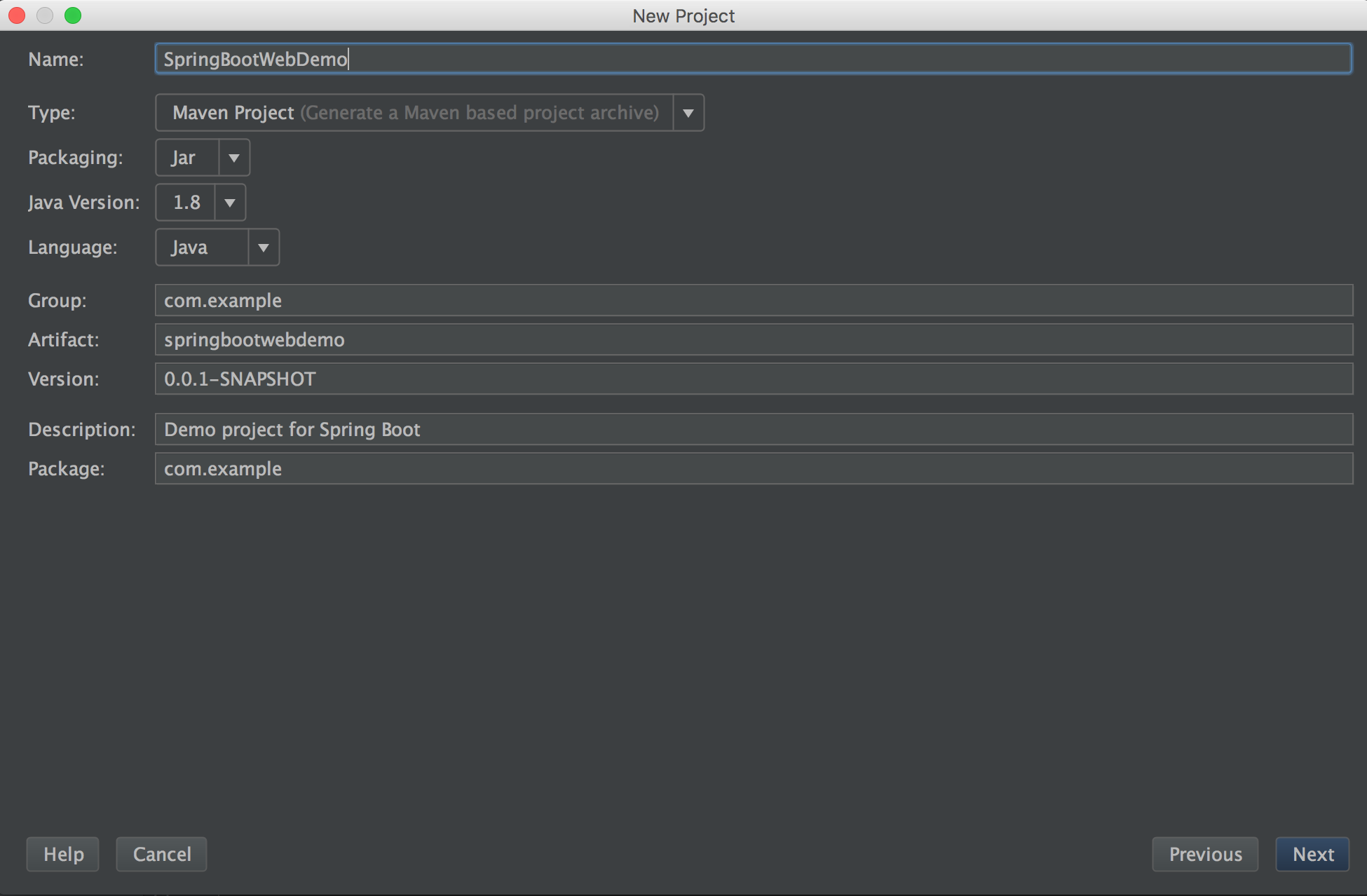
-
选择项目使用的依赖,这里我们只需要勾选web
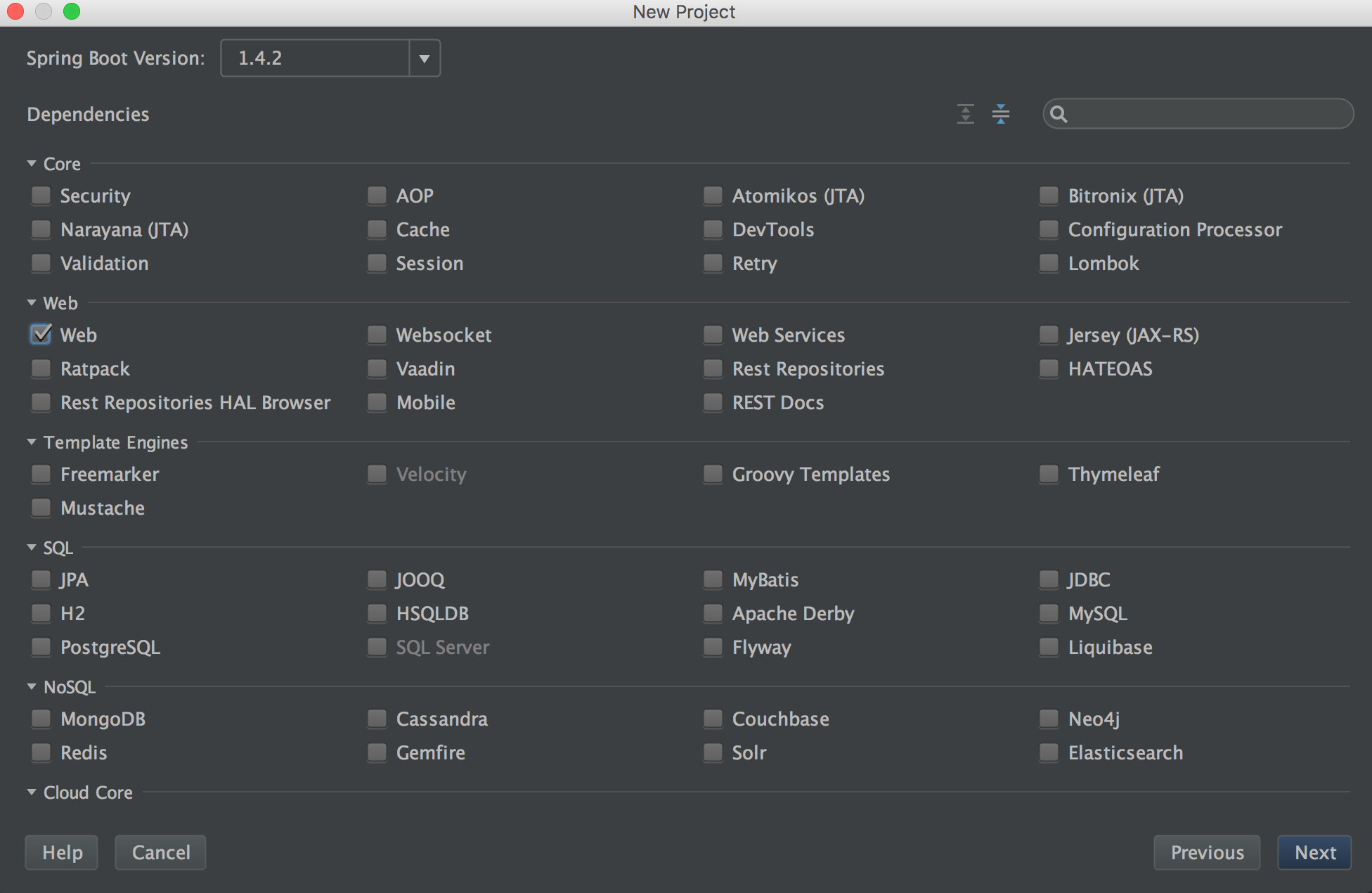
- Spring Boot当前最新的稳定版是1.4.2;
- 所有依赖可以在创建时勾选,也可以在创建后手工将依赖添加到pom中,如果对依赖比较熟悉,推荐手工添加,这样可以加快创建项目的时间;
-
填写项目名称,点击Finish
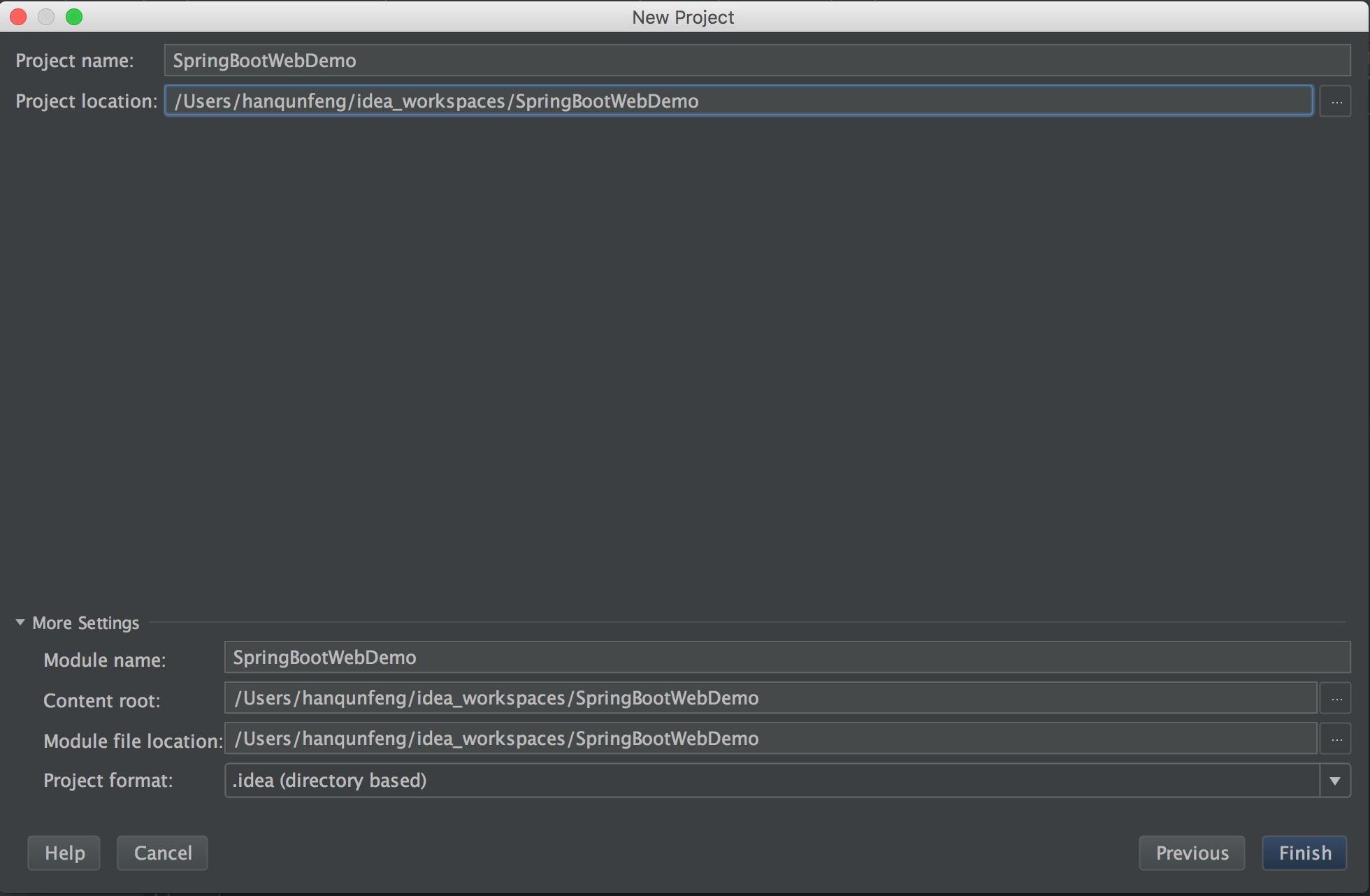
-
新建的项目结构如下

SpringBoot项目只会在项目根目录下生成一个类--SpringBootWebDemoApplication(artifactId+Application),它就是一个带有main函数的启动类;
package com.example;
import org.springframework.boot.SpringApplication;
import org.springframework.boot.autoconfigure.SpringBootApplication;
@SpringBootApplication
public class SpringBootWebDemoApplication {
public static void main(String[] args) {
SpringApplication.run(SpringBootWebDemoApplication.class, args);
}
}
- pom.xml说明
<?xml version="1.0" encoding="UTF-8"?>
<project xmlns="http://maven.apache.org/POM/4.0.0" xmlns:xsi="http://www.w3.org/2001/XMLSchema-instance"
xsi:schemaLocation="http://maven.apache.org/POM/4.0.0 http://maven.apache.org/xsd/maven-4.0.0.xsd">
<modelVersion>4.0.0</modelVersion>
<groupId>com.example</groupId>
<artifactId>springbootwebdemo</artifactId>
<version>0.0.1-SNAPSHOT</version>
<packaging>jar</packaging>
<name>SpringBootWebDemo</name>
<description>Demo project for Spring Boot</description>
<!-- 创建的Springboot项目需要继承于spring-boot-starter-parent -->
<parent>
<groupId>org.springframework.boot</groupId>
<artifactId>spring-boot-starter-parent</artifactId>
<version>1.4.2.RELEASE</version>
<relativePath/> <!-- lookup parent from repository -->
</parent>
<properties>
<project.build.sourceEncoding>UTF-8</project.build.sourceEncoding>
<project.reporting.outputEncoding>UTF-8</project.reporting.outputEncoding>
<java.version>1.8</java.version>
</properties>
<dependencies>
<!-- 创建项目是勾选的web依赖 -->
<dependency>
<groupId>org.springframework.boot</groupId>
<artifactId>spring-boot-starter-web</artifactId>
</dependency>
<!-- 每个项目都会自动添加一个test依赖 -->
<dependency>
<groupId>org.springframework.boot</groupId>
<artifactId>spring-boot-starter-test</artifactId>
<scope>test</scope>
</dependency>
</dependencies>
<build>
<plugins>
<!-- Springboot的编译插件 -->
<plugin>
<groupId>org.springframework.boot</groupId>
<artifactId>spring-boot-maven-plugin</artifactId>
</plugin>
</plugins>
</build>
</project>
这就是一个web项目的pom文件,可以看到只关联了很少的依赖,这是因为我们继承的spring-boot-starter-parent和关联的spring-boot-starter-web本身已经为我们关联了全部的依赖,如下是该项目所有的依赖包
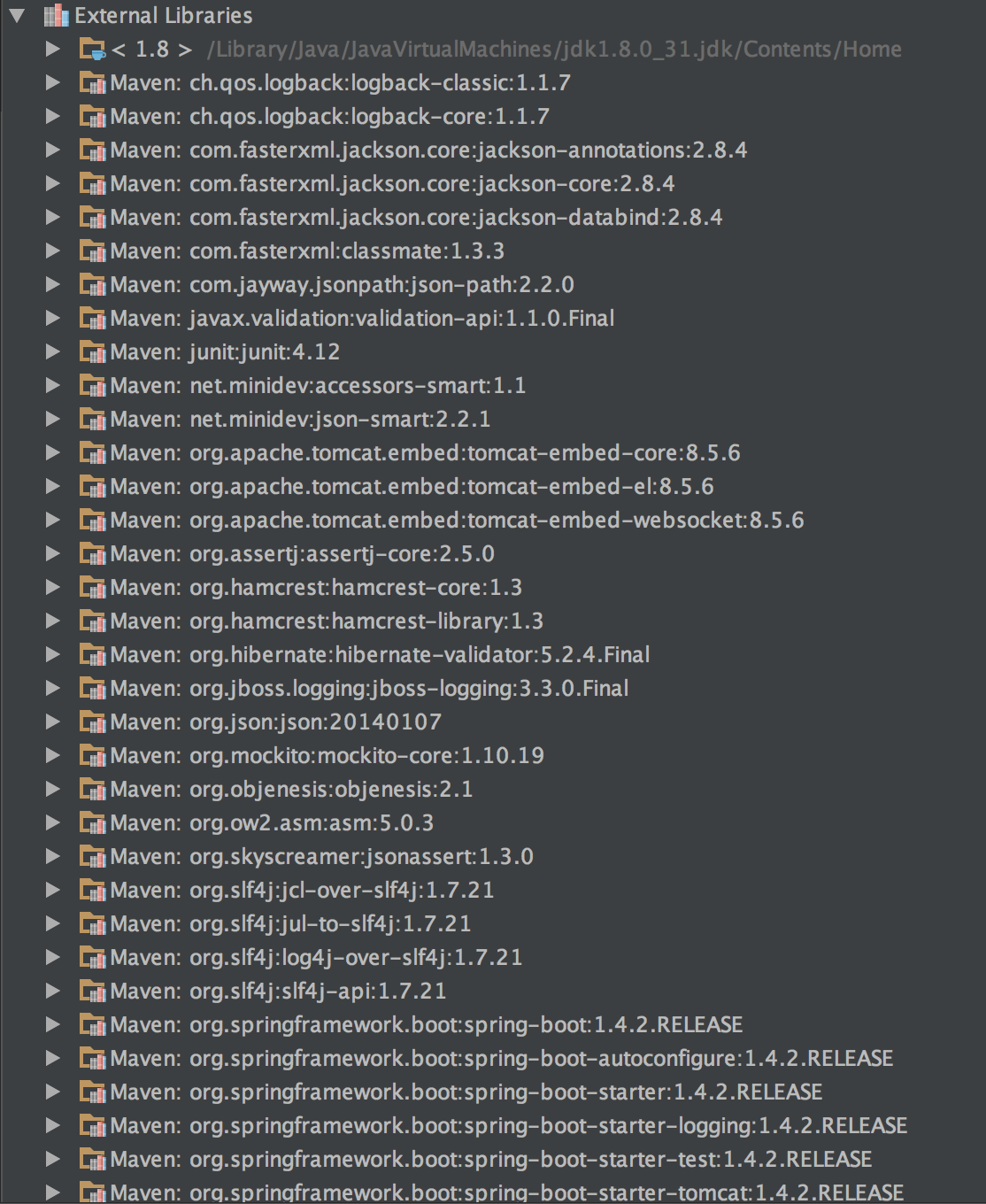
运行Spring Boot项目
- maven运行:
mvn spring-boot:run; - main函数运行:右键单击SpringBootWebDemoApplication,选择『Run 或者 Debug』;
- 推荐安装JRebel插件,支持热部署;
- 当然,也可以maven先打成jar,然后通过命令行执行
java -jar xx.jar;
运行成功会看到控制台打印了如下信息
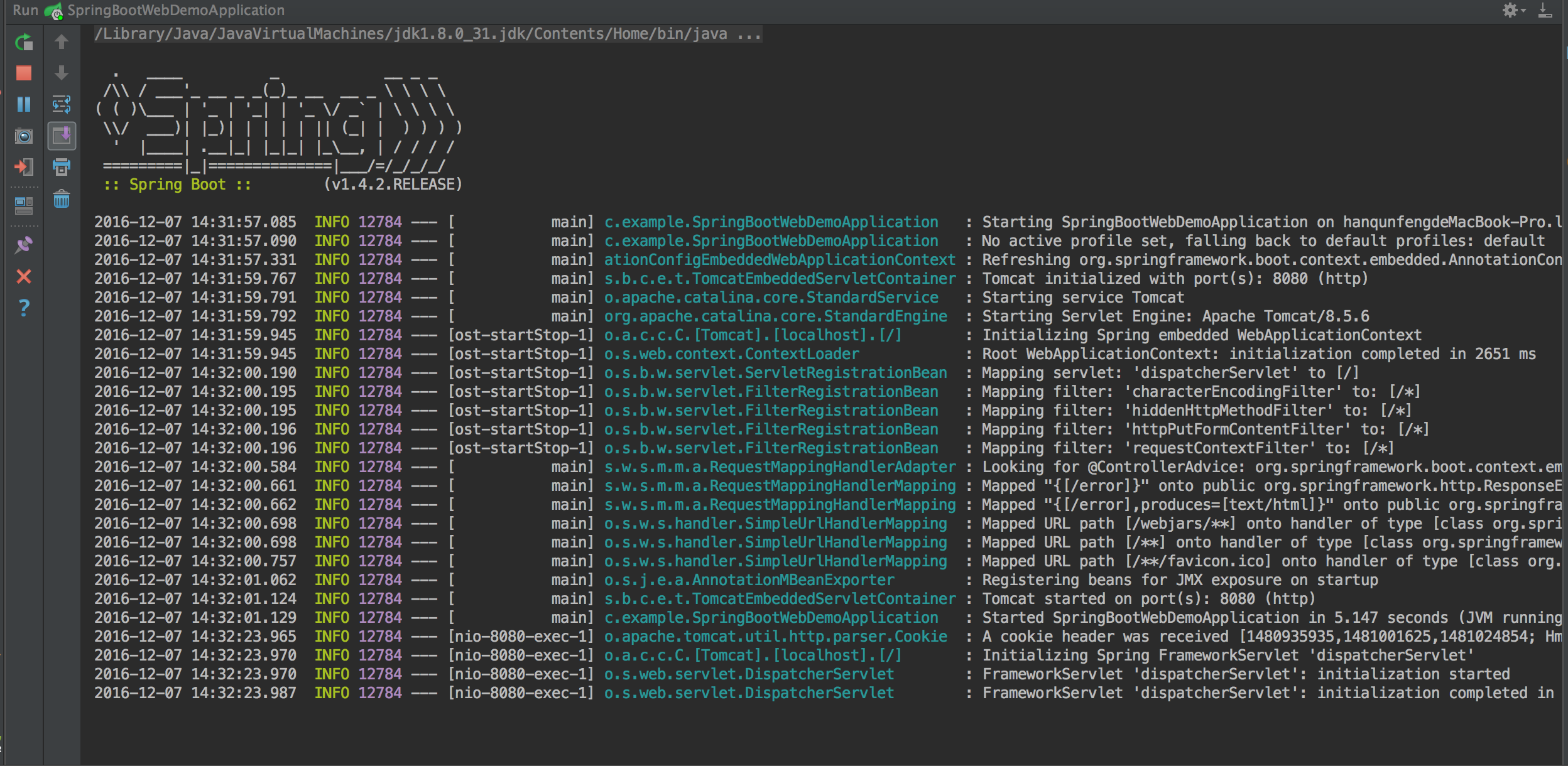
可以看到打印信息中有tomcat的启动信息,说明springboot默认使用tomcat作为web运行容器,这点从上面的依赖包中也可以看到。因为当前项目并没有开放任何服务,所以此时访问8080端口会提示无服务
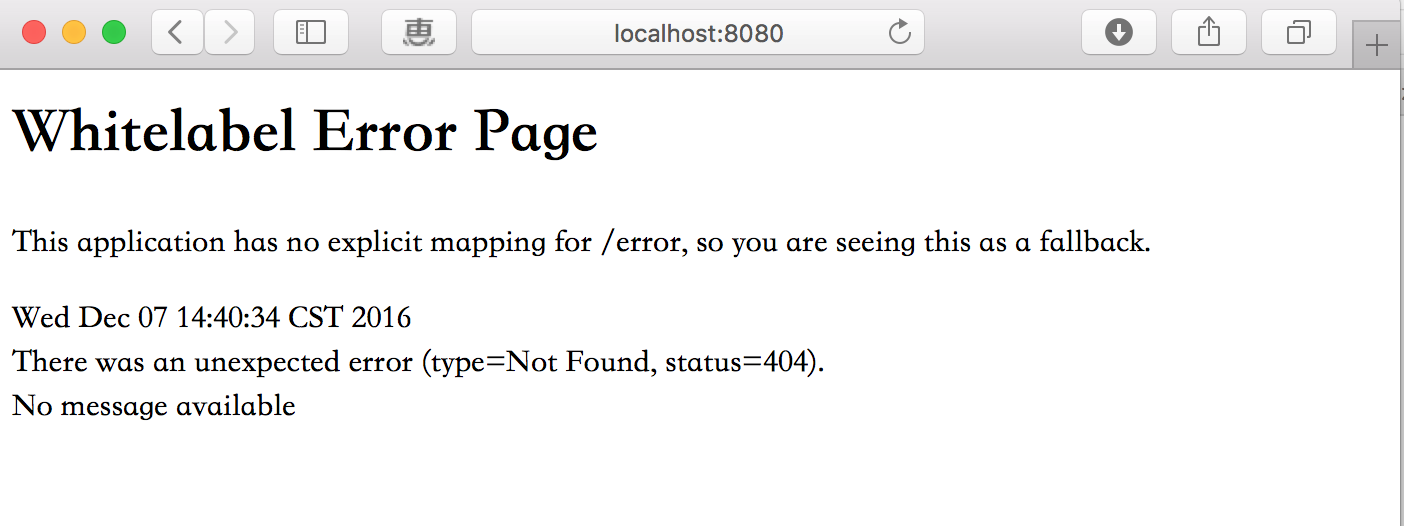
添加服务
- 我们可以在项目中创建一个Controller控制器,比如DemoController
package com.example.Controller;
import org.springframework.web.bind.annotation.RequestMapping;
import org.springframework.web.bind.annotation.RestController;
@RestController
public class DemoController {
@RequestMapping("/")
String index(){
return "Hello Spring Boot!";
}
}
- 运行SpringBootWebDemoApplication,再次访问http://localhost:8080

一切似乎就是那么美好,我们什么都没配置,一个web项目就这样运行起来了,SpringBoot自动帮我们默认了一些常用的配置
自动配置原理说明
SpringBootWebDemoApplication类上的注解:@SpringBootApplication
package org.springframework.boot.autoconfigure;
import java.lang.annotation.Documented;
import java.lang.annotation.ElementType;
import java.lang.annotation.Inherited;
import java.lang.annotation.Retention;
import java.lang.annotation.RetentionPolicy;
import java.lang.annotation.Target;
import org.springframework.boot.SpringBootConfiguration;
import org.springframework.boot.autoconfigure.EnableAutoConfiguration;
import org.springframework.boot.context.TypeExcludeFilter;
import org.springframework.context.annotation.ComponentScan;
import org.springframework.context.annotation.FilterType;
import org.springframework.context.annotation.ComponentScan.Filter;
import org.springframework.core.annotation.AliasFor;
@Target({ElementType.TYPE})
@Retention(RetentionPolicy.RUNTIME)
@Documented
@Inherited
@SpringBootConfiguration
@EnableAutoConfiguration
@ComponentScan(
excludeFilters = {@Filter(
type = FilterType.CUSTOM,
classes = {TypeExcludeFilter.class}
)}
)
public @interface SpringBootApplication {
Class<?>[] exclude() default {};
String[] excludeName() default {};
@AliasFor(
annotation = ComponentScan.class,
attribute = "basePackages"
)
String[] scanBasePackages() default {};
@AliasFor(
annotation = ComponentScan.class,
attribute = "basePackageClasses"
)
Class<?>[] scanBasePackageClasses() default {};
}
- @SpringBootConfiguration实际上就是@Configuration,说明这是一个JavaConfig
- @ComponentScan,启用注解自动扫描
- @EnableAutoConfiguration的作用是根据类路径中jar包是否存在来决定是否开启某一个功能的自动配置,比如,我们项目中添加了spring-boot-starter-web依赖,因其关联Tomcat和Srping MVC,所以类路径下就会存在Tomcat和Spring MVC的jar包,SpringBoot项目扫描到这些jar包后会自动开启两者的配置,当然,这个配置是默认配置,我们可以根据需要进行修改(下文介绍)。
- exclude和excludeName用于关闭指定的自动配置,比如关闭数据源相关的自动配置
@SpringBootApplication(exclude={DataSourceAutoConfiguration.class})
- scanBasePackages和scanBasePackageClasses用于指定扫描的路径,默认情况下会自动扫描被@SpringBootApplication注解的类(这里是SpringBootWebDemoApplication)的同级包以及子包中的Bean。比如我们创建的DemoController,因为开启了SpringMVC自动配置,同时又在对应的路径下,所以该Controller会被自动加载。比如我们这里指定扫描的包路径如下:
@SpringBootApplication(scanBasePackages = {"com.temp.Controller"})
再次运行程序,发现原来的DemoController不能被访问了,而『com.temp.Controller』下的controller却可以被访问。
那么问题来了,SpringBoot到底为我们自动配置了哪些功能呢?
- 开启Debug模式,方式有多种:
- java -jar xx.jar --debug
- 在IDE中执行Run时添加VM arguments:
-Ddebug- 在项目resources下的application.properties文件中增加
debug=true
- Debug模式运行程序,打印信息中会显示如下内容
启动的自动配置
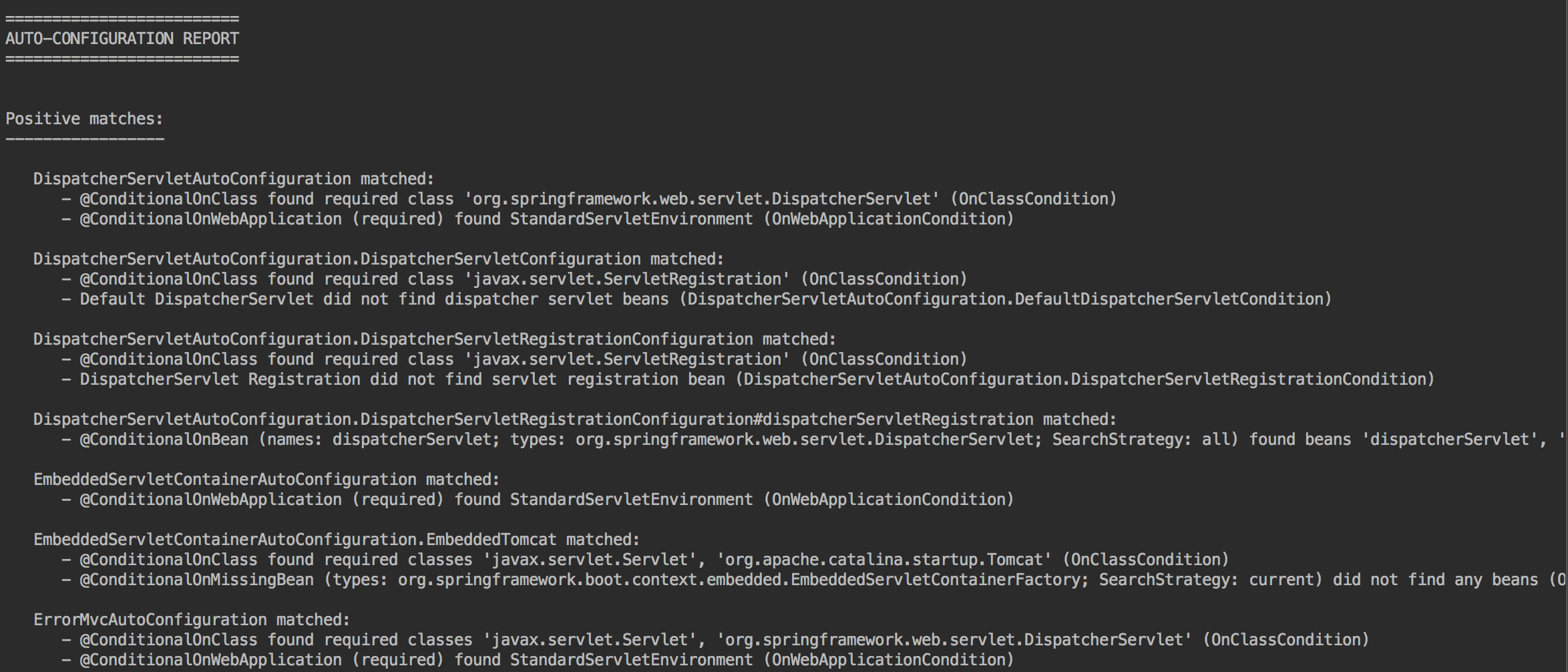
未启用的自动配置
- 从打印结果中看到,每一个
*AutoConfiguration*都对应着一类功能的自动配置类,比如HttpEncodingAutoConfiguration:
HttpEncodingAutoConfiguration matched:
- @ConditionalOnClass found required class 'org.springframework.web.filter.CharacterEncodingFilter' (OnClassCondition)
- @ConditionalOnWebApplication (required) found StandardServletEnvironment (OnWebApplicationCondition)
- @ConditionalOnProperty (spring.http.encoding.enabled) matched (OnPropertyCondition)
- 开启的自动配置中都会有
@ConditionalOnClass、@ConditionalOnWebApplication等标识,这是什么意思呢?为了弄清楚这个,我们需要先来认识一下@EnableAutoConfiguration;
@EnableAutoConfiguration
package org.springframework.boot.autoconfigure;
import java.lang.annotation.Documented;
import java.lang.annotation.ElementType;
import java.lang.annotation.Inherited;
import java.lang.annotation.Retention;
import java.lang.annotation.RetentionPolicy;
import java.lang.annotation.Target;
import org.springframework.boot.autoconfigure.AutoConfigurationPackage;
import org.springframework.boot.autoconfigure.EnableAutoConfigurationImportSelector;
import org.springframework.context.annotation.Import;
@Target({ElementType.TYPE})
@Retention(RetentionPolicy.RUNTIME)
@Documented
@Inherited
@AutoConfigurationPackage
@Import({EnableAutoConfigurationImportSelector.class})
public @interface EnableAutoConfiguration {
String ENABLED_OVERRIDE_PROPERTY = "spring.boot.enableautoconfiguration";
Class<?>[] exclude() default {};
String[] excludeName() default {};
}
- 这里我们需要了解一下@Import注解中的EnableAutoConfigurationImportSelector
感兴趣的可以看一下源码,大体的功能就是扫描jar包里是否含有
META-INF/spring.factories文件;
并在spring.factories中找到@EnableAutoConfiguration的全路径名称org.springframework.boot.autoconfigure.EnableAutoConfiguration这个key,该key对应的value就是用于声明都需要启用哪些自动配置类;
比如spring-boot-autoconfigure-1.4.2.RELEASE.jar中就有一个spring.factories,可以看到org.springframework.boot.autoconfigure.EnableAutoConfiguration参数中列出了自动配置类列表,而HttpEncodingAutoConfiguration这个自动配置类就是其声明的;
HttpEncodingAutoConfiguration
- 先看下源码
@Configuration
@EnableConfigurationProperties({HttpEncodingProperties.class})
@ConditionalOnWebApplication
@ConditionalOnClass({CharacterEncodingFilter.class})
@ConditionalOnProperty(
prefix = "spring.http.encoding",
value = {"enabled"},
matchIfMissing = true
)
public class HttpEncodingAutoConfiguration {
private final HttpEncodingProperties properties;
public HttpEncodingAutoConfiguration(HttpEncodingProperties properties) {
this.properties = properties;
}
@Bean
@ConditionalOnMissingBean({CharacterEncodingFilter.class})
public CharacterEncodingFilter characterEncodingFilter() {
OrderedCharacterEncodingFilter filter = new OrderedCharacterEncodingFilter();
filter.setEncoding(this.properties.getCharset().name());
filter.setForceRequestEncoding(this.properties.shouldForce(Type.REQUEST));
filter.setForceResponseEncoding(this.properties.shouldForce(Type.RESPONSE));
return filter;
}
//.......省略以下........
}
- 熟悉JavaConfig的都会明白,这就是一个配置类
@Configuration,并且通过@Bean注册了一个CharacterEncodingFilter;
但是还有一些注解,是什么意思呢,我们分别说明:
- @EnableConfigurationProperties:开启属性注入
本例中表示HttpEncodingProperties是属性类,并使用@Autowired自动注入;
属性类实际上是一个是注解了@ConfigurationProperties的JavaBean,SpringBoot将属性文件(application.properties)中的键值对与JavaBean的属性建立起一一对应关系:
@ConfigurationProperties(
prefix = "spring.http.encoding" //属性值的前缀
)
/*
举例:application.properties中设置如下属性
spring.http.encoding.charset=UTF-8
spring.http.encoding.force=true
*/
public class HttpEncodingProperties {
private Charset charset;
private Boolean force;
//....属性声明及set、get方法........
}
所有@ConditionalOn开头的注解都是用于进行条件判断的
- @ConditionalOnWebApplication:当前项目是web项目的条件下才加载当前配置类
- @ConditionalOnClass:当类路径下有指定的类的条件下才加载当前配置类
//本例表示,当前类路径(含jar)下必须存在CharacterEncodingFilter
@ConditionalOnClass({CharacterEncodingFilter.class})
- @ConditionalOnProperty:当指定的属性等于指定的值的情况下加载当前配置类
// spring.http.encoding=enabled
// matchIfMissing = true表示如果没有在application.properties设置该属性,则默认为条件符合
@ConditionalOnProperty(
prefix = "spring.http.encoding",
value = {"enabled"},
matchIfMissing = true
)
- @ConditionalOnMissingBean:当前容器里没有指定的Bean的情况下
// 如果当前容器中找不到CharacterEncodingFilter实例,则创建当前的Bean
@ConditionalOnMissingBean({CharacterEncodingFilter.class})
通过上面的分析,应该可以明白SpringBoot是如何做到自动配置的,简单总结如下:
- @SpringBootConfiguration实际上就是@Configuration,说明这是一个JavaConfig
- @EnableAutoConfiguration负责扫描jar包中的
META-INF/spring.factories来找到要初始化的各种AutoConfiguration类 - 各种@Conditional注解决定哪些Bean可以被容器初始化
- 如果希望进一步了解SpringBoot的自动配置,建议查看每一个AutoConfiguration类的源码
除了上面介绍的,@Conditional注解还有如下形式
- @ConditionalOnExpression:基于SpEL表达式作为条件判断
- @ConditionalOnJava:基于JAVA版本作为判断条件
- @ConditionalOnJndi:在JNDI存在的条件下查找指定的位置
- @ConditionalOnMissingClass:当前类路径下没有指定的类的条件下
- @ConditionalOnNotWebApplication:当前项目不是web项目的条件下
- @ConditionalOnResource:类路径下是否有指定的值
- @ConditionalOnSingleCandidate:当指定的Bean在容器中只有一个的情况下
如果我们希望自己创建一个自动配置类(AutoConfiguration),则只需要在我们自己创建的JavaConfig中加上@ConditionalOn注解,并且在类路径下创建META-INF/spring.factories,加入参数org.springframework.boot.autoconfigure.EnableAutoConfiguration=xxxxAutoConfiguration
SpringBoot的配置文件
- SpringBoot支持常规的properties配置文件(application.properties),还支持yaml语言的配置文件(application.yml)
- SpringBoot会从classpath下的/config目录或者classpath的根目录查找application.properties或application.yml
- 如果要修改SpringBoot自动配置中默认配置,可以通过在配置文件中配置相应的参数即可
- 比如,项目启动时,tomcat默认的端口号是『8080』,访问路径是『/』,修改如下:
- application.properties
server.port=8081
server.context-path=/demo
- application.yml
server:
port: 8081
context-path: /demo
- IntelliJ IDEA支持对properties和yml的代码提示功能,编辑起来还是很方便的,不需要特别记住这些属性名称
- SpringBoot默认使用priperites进行配置
SpringBoot的属性可以通过多种方式指定,配置文件只是其中一种方式,常用的方式还有如下几种,按加载的优先级列出:
命令行参数:
java -jar xx.jar --server.port=8081 --server.context-path=/demo
操作系统环境变量:有些OS不支持使用.这种名字,如server.port,可以使用SERVER_PORT来配置。
项目中的配置文件:application.properties或者application.yml
项目依赖jar包中的配置文件:application.properties或者application.yml
关于SpringBoot支持的配置属性可以查看官网地址1.4.2.RELEASE
Profile配置
- 不同的环境可以使用不同的配置文件,application-{profile}.properties,比如
开发:application-rnd.properties
测试:application-release.properties
验证:application-verify.properties
生产:application-prod.properties
- 通过在application.properties(项目中必须包含该文件)中设置
spring.profiles.active=prod来指定启用哪一个Profile。
关于属性配置还想多说的一些内容
- application.properties也可以配置自定义属性:my.name=hanqf
- 通过
@Value将属性注入Bean属性
@Value("${my.name}")
private String myName;
- 通过
@ConfigurationProperties将属性注入Bean对象
使用prefix
my.name=hanqf
my.servers[0]=rnd.hanqf.com
my.servers[1]=release.hanqf.com
@ConfigurationProperties(prefix="my")
public class Config {
private String name;
private List<String> servers = new ArrayList<String>();//list需要初始化
//....set and get method
}
不使用prefix
name=hanqf
jdbc.username=root
jdbc.password=root
@ConfigurationProperties
public class Config {
private String name;
private Jdbc jdbc;
class Jdbc {
private String username;
private String password;
//....set and get method
}
//....set and get method
}
- 属性占位符
app.name=MyApp
app.description=${app.name} is a Spring Boot application
server.port=${port:8080} # 如果没有设置port,则使用默认值8080
- 属性名匹配规则
@ConfigurationProperties(prefix="person")
public class Config {
private String firstName;
//....set and get method
}
firstName可以使用的属性名如下:
person.firstName,标准的驼峰式命名
person.first-name,虚线(-)分割方式,推荐在.properties和.yml配置文件中使用
PERSON_FIRST_NAME,大写下划线形式,建议在系统环境变量中使用
日志配置
- Spring Boot默认使用Logback作为日志框架,这是推荐的方式,如果希望修改为熟悉的log4j可以看下文
创建项目时我们引入了
spring-boot-starter-web,其依赖spring-boot-starter,spring-boot-starter又依赖于spring-boot-starter-logging,该依赖内容就是Spring Boot默认的日志框架Logback
Logback相关设置,可以在application.properties中进行如下配置:
# 日志文件路径
logging.file=D:/my_log.log
# 配置日志打印级别
logging.level.org.springframework=INFO
当然,也可以直接将自己的
logback.xml放到项目根路径下
- 修改为log4j框架
pom中排除对spring-boot-starter-logging的依赖,并加入对spring-boot-starter-log4j的依赖
目前maven中央仓库的最新版本是1.3.8.RELEASE
<dependency>
<groupId>org.springframework.boot</groupId>
<artifactId>spring-boot-starter</artifactId>
<exclusions>
<exclusion>
<groupId>org.springframework.boot</groupId>
<artifactId>spring-boot-starter-logging</artifactId>
</exclusion>
</exclusions>
</dependency>
<dependency>
<groupId>org.springframework.boot</groupId>
<artifactId>spring-boot-starter-log4j</artifactId>
<version>1.3.8.RELEASE</version>
</dependency>
项目根路径下添加log4j.properties
- 修改为log4j2框架
与log4j类似,修改pom,增加spring-boot-starter-log4j2依赖
目前maven中央仓库的最新版本是1.4.2.RELEASE
<dependency>
<groupId>org.springframework.boot</groupId>
<artifactId>spring-boot-starter</artifactId>
<exclusions>
<exclusion>
<groupId>org.springframework.boot</groupId>
<artifactId>spring-boot-starter-logging</artifactId>
</exclusion>
</exclusions>
</dependency>
<dependency>
<groupId>org.springframework.boot</groupId>
<artifactId>spring-boot-starter-log4j2</artifactId>
<version>1.4.2.RELEASE</version>
</dependency>
项目根路径下添加log4j2.xml
说明
这里需要说明一个问题,如果切换为其它log框架,debug=true将会失效,需要在各自的log配置文件中声明,比如log4j需要添加log4j.logger.org.springframework.boot=debug
修改内置Tomcat为Jetty
- 修改pom,去除
spring-boot-starter-tomcat的依赖,增加spring-boot-starter-jetty依赖
目前maven中央仓库的最新版本是1.4.2.RELEASE
<dependency>
<groupId>org.springframework.boot</groupId>
<artifactId>spring-boot-starter-web</artifactId>
<exclusions>
<exclusion>
<groupId>org.springframework.boot</groupId>
<artifactId>spring-boot-starter-tomcat</artifactId>
</exclusion>
</exclusions>
</dependency>
<dependency>
<groupId>org.springframework.boot</groupId>
<artifactId>spring-boot-starter-jetty</artifactId>
<version>1.4.2.RELEASE</version>
</dependency>
-
application.properties中的属性配置与tomcat一致
修改内置Tomcat为Undertow容器
- 修改pom,去除
spring-boot-starter-tomcat的依赖,增加spring-boot-starter-undertow依赖
目前maven中央仓库的最新版本是1.4.2.RELEASE
<dependency>
<groupId>org.springframework.boot</groupId>
<artifactId>spring-boot-starter-web</artifactId>
<exclusions>
<exclusion>
<groupId>org.springframework.boot</groupId>
<artifactId>spring-boot-starter-tomcat</artifactId>
</exclusion>
</exclusions>
</dependency>
<dependency>
<groupId>org.springframework.boot</groupId>
<artifactId>spring-boot-starter-undertow</artifactId>
<version>1.4.2.RELEASE</version>
</dependency>
-
application.properties中的属性配置与tomcat一致
单元测试
- 创建一个单元测试的抽象父类,用于初始化必要的对象
package com.common;
import org.junit.Before;
import org.junit.runner.RunWith;
import org.springframework.beans.factory.annotation.Autowired;
import org.springframework.boot.test.context.SpringBootTest;
import org.springframework.test.context.junit4.SpringRunner;
import org.springframework.test.web.servlet.MockMvc;
import org.springframework.test.web.servlet.setup.MockMvcBuilders;
import org.springframework.web.context.WebApplicationContext;
@RunWith(SpringRunner.class)
//1.4.2.RELEASE中不再需要@SpringApplicationConfiguration和@WebAppConfiguration
@SpringBootTest
public abstract class SpringBootTestParent {
public MockMvc mockMvc;
@Autowired
WebApplicationContext webApplicationContext;
@Before
public void setUp() throws Exception {
mockMvc = MockMvcBuilders.webAppContextSetup(webApplicationContext).build();
}
}
- 继承抽象父类,并实现测试逻辑
public class SpringBootWebDemoApplicationTests extends SpringBootTestParent{
@Autowired
DemoService demoService;
@Test
public void content(){
String content = "456";
System.out.println(demoService.printContent(content));
Assert.assertEquals(content,demoService.printContent(content));
}
@Test
public void DemoControllerContent(){
String uri = "/content/123";
MvcResult mvcResult;
try {
mvcResult = mockMvc.perform(MockMvcRequestBuilders.get(uri)).andReturn();
System.out.println(mvcResult.getResponse().getStatus() + "##" + mvcResult.getResponse().getContentAsString());
} catch (Exception e) {
e.printStackTrace();
}
}
}
使用war包的形式运行项目
上面我们介绍了SpringBoot通过jar的形式运行项目的方法,这也是SpringBoot推荐的方式,因其内置Servlet容器,所以发布和部署都非常方便,但是某些情况下(比如使用JSP作为VIEW层,内置容器的形式并不能支持),我们希望将web项目部署到自己的容器中,这时候就需要将SpringBoot项目打成war包部署,有两种方式:
1.创建项目时打包方式选择:war
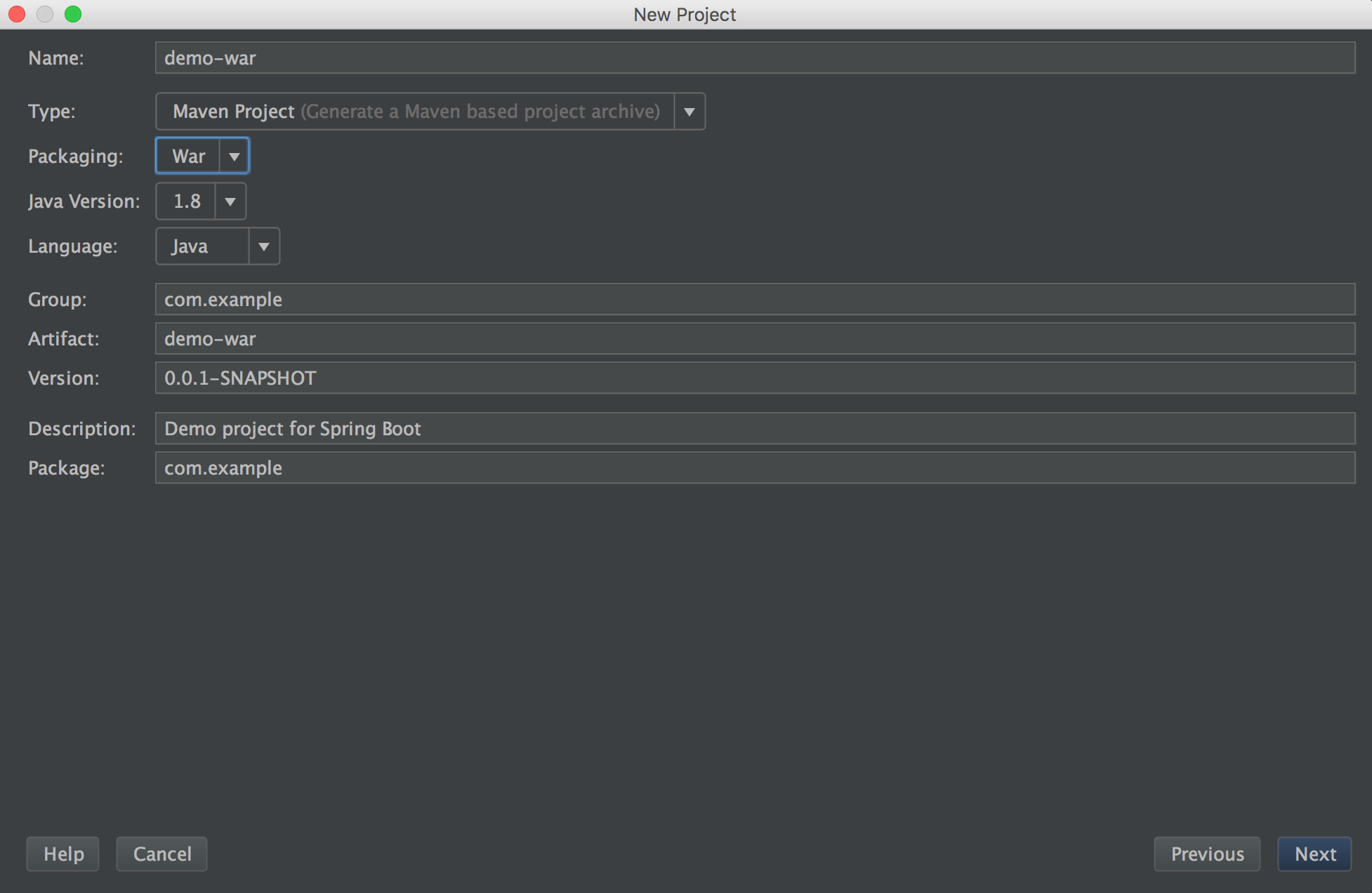
war项目目录结构
2.将原打包方式为jar的项目修改为war形式
与war项目对比发现,通过修改如下内容,可以将jar项目修改为war项目
2.1 pom中将<packaging>jar</packaging>==><packaging>war</packaging>
2.2 pom中添加tomcat依赖,显示声明scope为provided,这样打包时就不会将tomcat的jar包打到war中
<dependency>
<groupId>org.springframework.boot</groupId>
<artifactId>spring-boot-starter-tomcat</artifactId>
<scope>provided</scope>
</dependency>
2.3 创建ServletInitializer类
public class ServletInitializer extends SpringBootServletInitializer {
@Override
protected SpringApplicationBuilder configure(SpringApplicationBuilder application) {
return application.sources(DemoWarApplication.class);
}
}
说明
- Servlet3.0规范,支持将web.xml相关配置也硬编码到代码中,并由
javax.servlet.ServletContainerInitializer的实现类负责在容器启动时进行加载 - spring提供了一个实现类
org.springframework.web.SpringServletContainerInitializer,
该类会调用所有org.springframework.web.WebApplicationInitializer的实现类的onStartup(ServletContext servletContext)方法,从而将相关的容器组件注册到容器; - SpringBootServletInitializer就是WebApplicationInitializer的实现类;
- 我之前写过一篇SpringMVC4零配置的文章,对零配置感兴趣的同学可以参考。

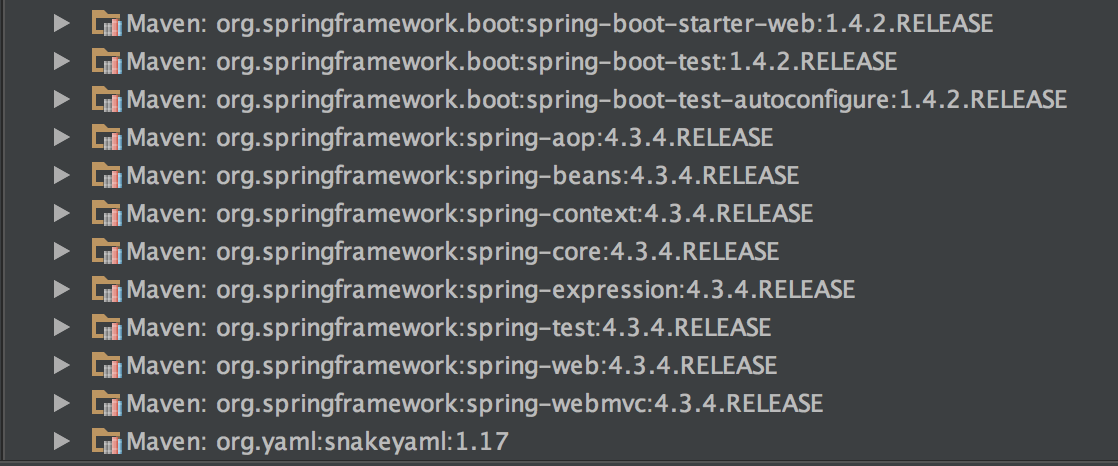
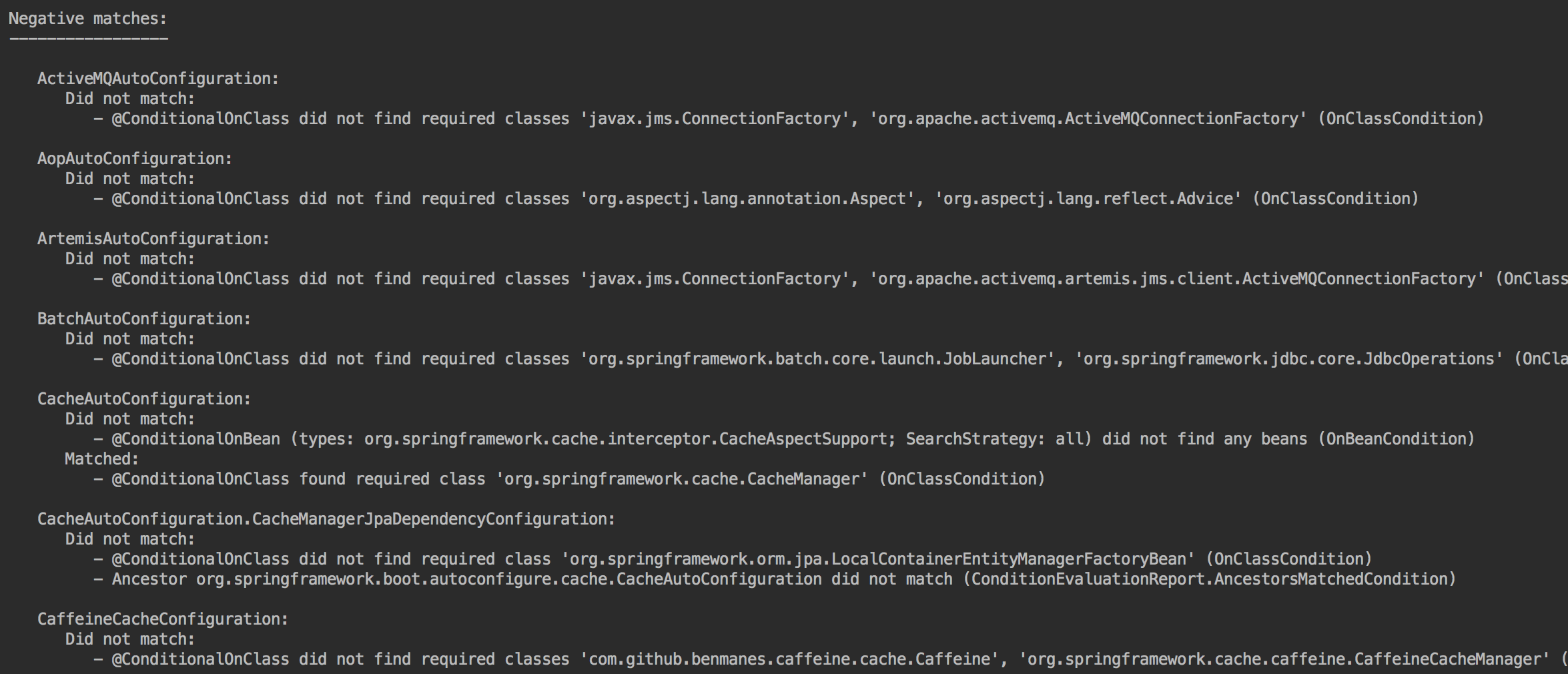
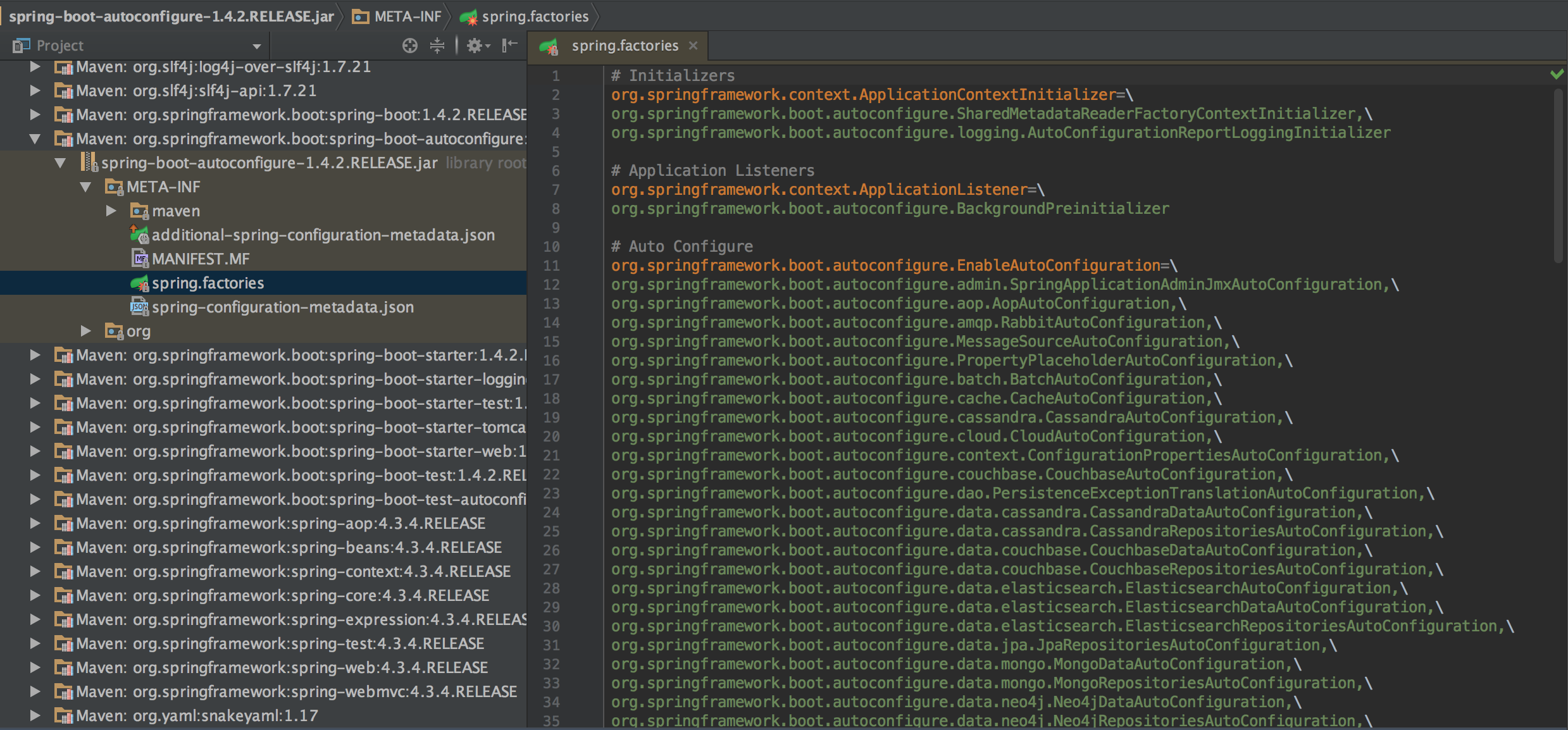













网友评论